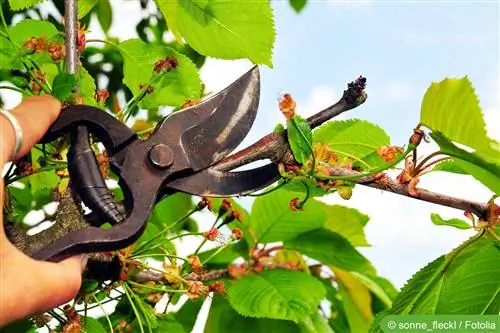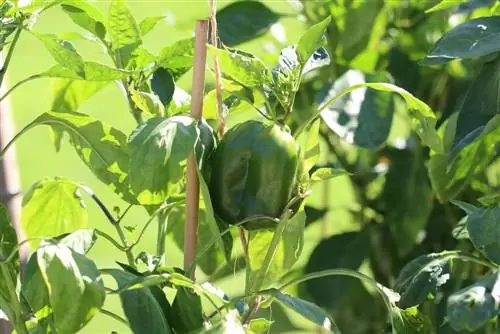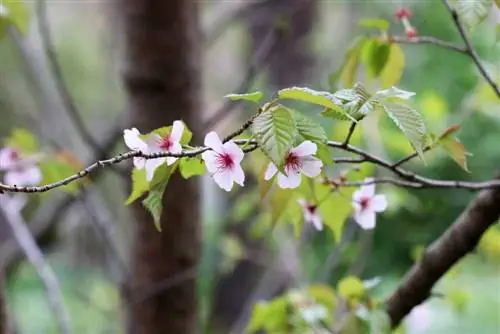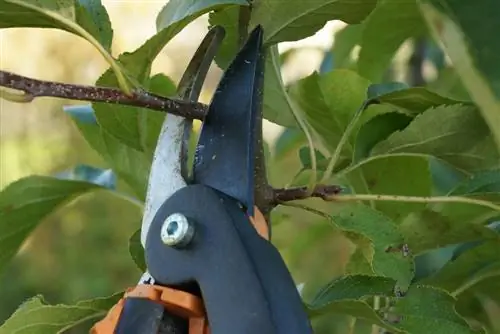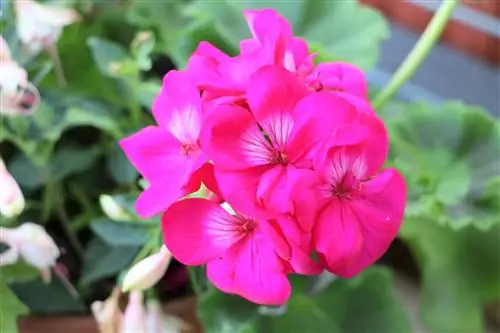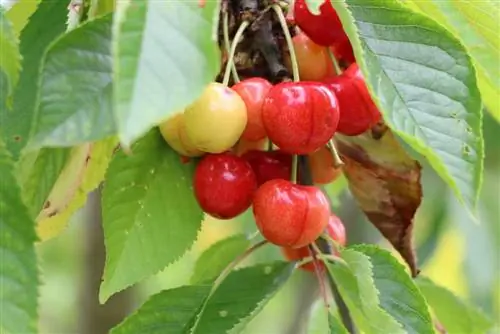- Author admin [email protected].
- Public 2023-12-17 03:39.
- Last modified 2025-01-24 12:45.
In this country, there are one or more cherry trees in around 20 million private gardens, which means that 20 million households can look forward to home-picked cherries every year. However, these churches often have a quality that really cannot be said to be true cherry enjoyment!
This flaw is certainly due to the fact that many people do not have sufficient knowledge about the correct treatment of a cherry tree. This starts with the right cherry tree pruning. From the time of cutting to the correct cutting itself, there are a lot of important basics to consider when cutting.
When is the right time to prune the cherry tree?
The optimal time for cutting is definitely in summer, ideally immediately after the cherry harvest. In this way, the sometimes extreme growth of the tree can be controlled, which guarantees an optimal harvest next year. However, it depends largely on whether it is a sweet cherry tree or a sour cherry tree. The sweet cherry tree should be cut in late summer, while the sour cherry tree should be cut earlier. If the tree is cut later, the wounds caused by the cut on the tree will not heal optimally due to the autumnal precipitation, which ultimately affects the cherry quality in the following year.
Does the cutting have to be done every year?
The annual cherry tree pruning is an important part of tree care and has a high impact on cherry quality. Due to the fact that cherry trees - unlike apple trees - can reach quite an impressive size, it is necessary to prune them annually, and not just from an optical point of view. In this way, the formation of new shoots can be optimally guaranteed, which results in fresh and tasty cherries.
How is the correct tree pruning done?
Even if a cutting is carried out correctly, it largely depends on which type of cherries can be expected as a harvest. The most common in this country is the sweet cherry, which enjoys a so-called upbringing. It is this upbringing that ultimately determines tree pruning. If the sweet cherry is to be grown in the bush, the optimal trunk length is approx. 60 cm. In order to achieve this length, the tree owner should select well-developed side shoots on the tree and cut them back to this length.
With an optimal cut, all side shoots will then be on one level. In this way, the development of the crop is optimally advanced, as conspicuously protruding shoots are separated from the main trunk. However, the lengthening of the actual main trunk is not pushed quite as far when cutting; ideally you should allow 10 cm more for these extensions.
If a so-called spindle training of the cherry is to take place, the shape of the cut must be chosen differently. When training the spindle, a measurement of 60 cm is also used, but any side shoots that extend beyond this are not cut off, but are simply tied off towards the bottom. There are special clamps for this in various hardware stores, but it is also possible to use cords or ropes that are typical for household use. In contrast to the bush training of the cherry, the stem extension is also spared from the cherry tree pruning. Only the buds that have grown below the tip bud are removed. However, it is extremely important to ensure that the right shoots are removed. If incorrect shoots or trunk extensions are removed, this can have a massive and noticeable impact on the cherry harvest.
For unsure hobby gardeners, it is therefore strongly recommended that they consult appropriate reading material before attempting to prune the cherry tree. If possible, this reading should be illustrated so that there can be no more misunderstandings. When it comes to pruning the cherry tree itself, one thing is crucial for both cherry varieties: Even if the main trunk appears strong and he althy, extreme caution is advised. The procedure should be carried out extremely carefully and with disinfected garden tools, as trees can quickly become weak and sick if treated incorrectly or carelessly. Pruning is an intervention in the he alth of the tree, which, if carried out correctly, can contribute to its aging and he alth. However, if a hobby gardener approaches this cherry tree pruning carelessly, the opposite effect can very quickly be triggered.
What else needs to be taken into account?
At the end of each cutting, a branch structure of four branches is completely sufficient. Because these branches have enough space for their own development, optimal development is guaranteed, which ultimately makes the tree crown more stable. When it comes to the question of stability, it is important that this should not be achieved through growth that is too dense. Thinning out the treetop is therefore absolutely necessary. This can be done as part of the cherry tree pruning, but more frequent thinning is not harmful to the tree. As a rule of thumb goes, the tree crown needs to be completely cut once every five years.
As with all things in life, when pruning the cherry tree, the safety of the person doing it should be the top priority. Many accidents occur in the garden due to careless actions. Since cherry trees can reach an impressive height, a ladder is often required to carry out the cut. However, this should be leaned on the main trunk and not on the branches of the tree, as the branches can break much more easily. In addition to disinfected cutting tools, the hobby gardener should be familiar with using them, as this can also lead to an increased risk of accidents.
Conclusion: If these tips are followed, the tree owner will be able to enjoy their cherry tree for many years to come. The tree will remain he althy and thank its owner with tasty and high-quality cherries.
Things worth knowing about cherry tree pruning coming soon
How does the cherry tree in the home garden stay fit even after years and delight the owner every year with a large display of delicious and juicy red cherries?
- Pruning is extremely important for the cherry tree and is even more important than for the apple tree, for example. Because cherry trees are also known for reaching an impressive size and developing particularly strongly.
- So that this development can take place even more optimally, when cutting back, the shoots that stand out noticeably upwards are first cut off. In the end it is enough to retain a branch structure made up of up to four branches.
- These can develop ideally thanks to their freedom of space and the removal of annoying old and unnecessary branches. The result is quickly noticeable, namely that the crown becomes more stable. This should be more stable, but of course not too densely overgrown.
- That's why thinning is also recommended here as part of the cherry tree pruning. The crown can be thinned out more often and even in the early years when you got or planted the cherry tree when it was still very young.
- A complete cut is only necessary after the fifth year.
- Cherry tree pruning should be done in summer if possible, in winter frost damage can occur as wound healing is difficult to manage.
- So-called maintenance pruning is particularly necessary for older cherry trees. This means that the cherry tree is then trimmed accordingly so that thick, rotten and old branches that no longer bear cherries or only a few have to go.
- Instead, young branches that contain a lot of cherries should be able to develop better. Preservation pruning - as the name suggests - preserves the tree in its splendor and ensures that it continues to be productive.
- The garden owner has to take on the care and pruning work, but the effort is worth it and pays off with every harvest.

